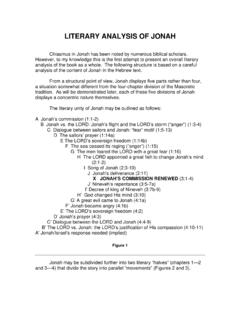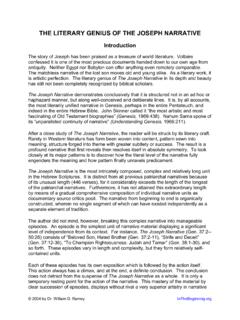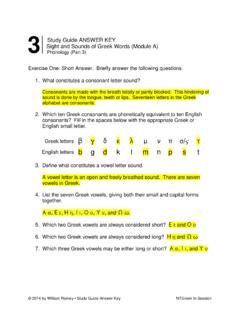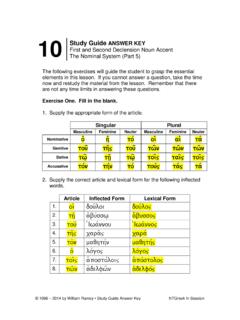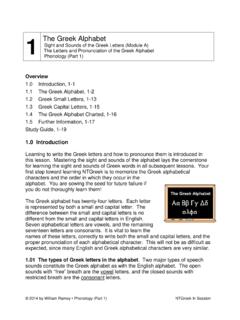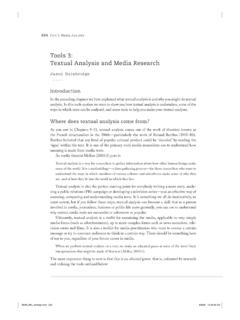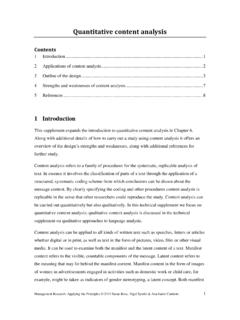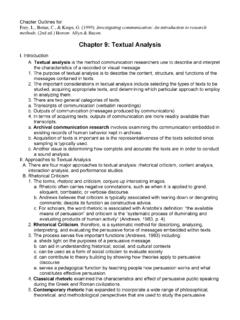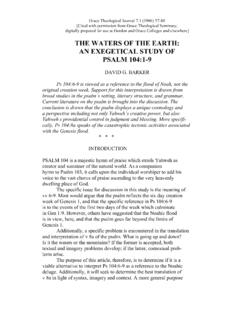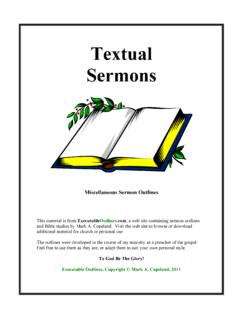Transcription of LITERARY ANALYSIS OF GENESIS 1:1—2:3 Introduction
1 LITERARY ANALYSIS OF GENESIS 1:1 2:3 Introduction (Personal Testimony)When I was in my introductory philosophy class ( Introduction to Logic and theScientific Method ) during my first semester freshman year at the University of Missouriat Columbia in 1972, the professor sarcastically used GENESIS 1:1 2:3 to show thealleged illogical inconsistencies and discrepancies of the LITERARY biblical creation the end of the series of lectures, he summarily rejected the entire account as was not to be an isolated incident during my academic years. In all of mybiology, chemistry, physic, anthropology, physiology, psychology and sociology classes,the same attitude prevailed. How can a student combat such a formidable and galvanizedaffront toward the Scriptures?
2 Especially if it comes from an university professor whodegrades the Bible before the class and snickers at the thought of anyone reading it, letalone owning one! After all, is not the university where one goes to obtain higherlearning? Is not the professor always correct?Unknowingly to me at the time, these confrontations fueled and shape my thirstfor biblical LITERARY understanding. After many years of studying both the Old and NewTestaments in the original languages, it is my personal conviction that a Christian candefend the LITERARY and theological unity of the Creation Account; but not through the lensof western LITERARY ANALYSIS , but that of ancient Near Eastern, the LITERARY milieu in whichthe text was originally following study offers an introductory step for a Christian to appreciate theliterary unity and theological thrust behind the Creation Account.
3 Admittedly, because ofthe foreign method by which the ancient Near East composed their documents, themethod is alien to modern experience and difficult to appreciate at first blush. But for thereader who is willing to study the general principles of parallel structure, the LITERARY andtheological rewards are D. RameyApril 5, ANALYSIS of GENESIS 1:1 2:3 Page majestic opening of GENESIS 1:1 2:3 forms the first major LITERARY section ofboth the Hebrew and the Christian Bible. The second section begins with GENESIS 2:4with the words, This is the account of the heavens and the earth when they were created,in the day that the LORD God made earth and heaven (NASB) and continues throughGenesis 4:26 which traces what became of the universe God had so marvelously created:mankind became disqualified to rule in God s likeness and image (Gen.)
4 1:26-28)because of disobedience (3:1-7), resulting deterioration throughout the human , GENESIS 2:1-3 echoes GENESIS 1:1 by introducing paralleling phrases orconcepts, but in reverse order in the Hebrew text (Figure 1).The LITERARY Structure of GENESIS 1:1 2:3A He [God] created ()rb; 1:1b)B God (Myhwl); 1:1b)C heavens and earth (Cr)hw Mym#$h; 1:1b)XFORMING AND FILLING OF THE EARTH (1:2-31)C heavens and earth (Cr)hw Mym#$h; 2:1)B God (Myhwl); 2:2)A He [God] had made (h#&(; 2:3)Figure chiastic pattern brings the section to a neat LITERARY conclusion which is reinforced bythe inclusion God created , linking GENESIS 1:1 and 2:3, God had made . The entiresection stands apart from the episodes which ensues in style and content, thus making itthe overture to the entire work of GENESIS , that of the Torah, and indeed, the entire commentators, both ancient and modern, and a few editors of the Englishversions (NIV; NEB; NJB) have regarded GENESIS 2:4a not functioning as a heading towhat follows, but as a postscript to what precedes, the account of creation in Genesis1:1 2:3.
5 It is argued that GENESIS 2:4a makes a neat inclusio with GENESIS 1 , there are problems that discourage dividing GENESIS 2:4 in this , the formula this is the account in GENESIS 2:4a, if taken as a summary, would differfrom its common use in GENESIS where it uniformly refers to genealogy or narrative thatfollows, not precedes. Second, because of the chiastic structure of GENESIS 2:4 (Figure 2),it seems preferable to understand the entire verse as a structural unity, and thus as a title to GENESIS 2:5 4:26. Likewise understanding GENESIS 2:4 commencing a new sectionallows full weight to be given to the chiastic structure of GENESIS 1:1 2:3 (Figure 1), andLiterary ANALYSIS of GENESIS 1:1 2:3 Page recognition that the name LORD God does not occur once in GENESIS 1:1 2:3, butmany times in GENESIS 2:5 3 , what matches GENESIS 1:1 is not 2:4a but 2:1-3, where the seventh dayserves as a satisfying denouement to the account s narrative progression.
6 The key termsof GENESIS 1:1 ( created ; God ; the heavens ; the earth ) are repeated in GENESIS 2:1-3 but in reverse order (Figure 2), which clearly indicates that GENESIS 2:1-3 forms theinclusio ending to the first section without the unnecessary first half of GENESIS 2 LITERARY Structure of GENESIS 2:4A heaven (Mym#$h)B earth (Cr)h)C created ()rb)C made (h#&()B earth (Cr)h)A heaven (Mym#$h)Figure purpose of the repetition of the starting point of creation in GENESIS 2:4 is to establishthe context for understanding the ensuing story of human sin and its devastatingconsequences on the human race and Sevens of GENESIS 1:1 2:3 The correspondence of the first paragraph, GENESIS 1:2 with 2:1-3, isunderscored by the number of Hebrew words in both being multiples of seven.
7 Genesis1:1 consists of seven (7x1) Hebrew words, GENESIS 1:2 consists of fourteen (7x2) words,and GENESIS 2:1-3 thirty-five (7x5) words. In addition, God is mentioned thirty-five(7x5) times, earth occurs twenty-one (7x3) times, and heaven/firmament also twenty-one (7x3) number seven also dominates GENESIS 1:1 2:3 in a startling way, not onlyin the number of words in a particular section, but also in the number of times a specificword or phrase recurs, which in all comprises the sevenfold patterning of this section: Seven paragraphs: The arrangement of GENESIS 1:1 2:3 consists of anintroduction and seven paragraphs. The Introduction identifies the Creator andcreation (Gen. 1:1-2); six paragraphs corresponds to the six creation days (1:3-21).
8 The seventh paragraph marks the climactic seventh day, the day ofconsecration (2:1-3). LITERARY ANALYSIS of GENESIS 1:1 2:3 Page The announcement of the commandment: And God said , while occurring tentimes, is grouped into seven (7x1) groups (Gen. 1:3; 6; 1:9; 1:11; 1:14, 1:20;1:24; 1:26, 28, 29). The order formula: Let there be .. , while occurring eight times, the formulais grouped into seven (Gen. 1:3; 1:6, 9; 1:11; 1:14; 1:20; 1:24; 1:26). The fulfillment formula: And it was so occurs seven times (Gen. 1:3; 1:7; 1:9;1:11; 1:15; 1:24; 1:30). The execution formula: And God made occurs seven times (Gen. 1:4; 1:7;1:12; 1:16; 1:21; 1:25; 1:27). The approval formula: God saw that it was good occurs seven times ( :4; 1:10; 1:12; 1:18; 1:21; 1:25; 1:31).
9 The subsequent divine word: God s naming or blessing occurs seven times(Gen. 1:52; 1:8; 1:102; 1:22; 1:28). Seven days affirmed: There are seven days mentioned (Gen. 1:5; 1:8; 1:13;1:19; 1:23; 1:31; 2:2).Although there are ten announcements of the divine word (#1 above) and eight commandsactually cited (#2 above), the formulae are grouped in sevens. The intentional sevenfoldpattering of GENESIS 1:1 2:3 is only maintained by our author skillfully and intentionallyomitting some of these formulae: the fulfillment formula is omitted in GENESIS 1:5 (Day 5),the description of the act in GENESIS 1:9 (Day 3), and the approval formula in GENESIS 1:6-8 (Day 2). Whereas in each case the Septuagint (LXX; the Greek translation of theHebrew Scriptures by seventy men) mistakenly adds the appropriate formula, theseadditions obscure the original sevenfold pattern of this LITERARY Structure of the Six Days of CreationThe following parallel columns clearly indicate that the creation account isorganized in two parallel groups of three (Figure 3).
10 In the first group, regions arecreated: night and day, firmament (and atmosphere) and oceans, and the land. In thesecond group, the corresponding inhabitants of these regions are created: astronomicalbodies, birds and fish, land animals and man. This however, raises another perennialquestion: why are the plants created on Day 3 rather than on Day 6? The plants, wewould think, should be grouped with the living beings rather than the earth. Whatclassification criterion was the author using that put the plants even before the sun?A clue to this comes from the peculiar description of the animals of dry land: cattle and creeping things and beasts on the earth . We can say that this phrase isintended as a synecdoche for all living land animals, but why select these asrepresentatives?
